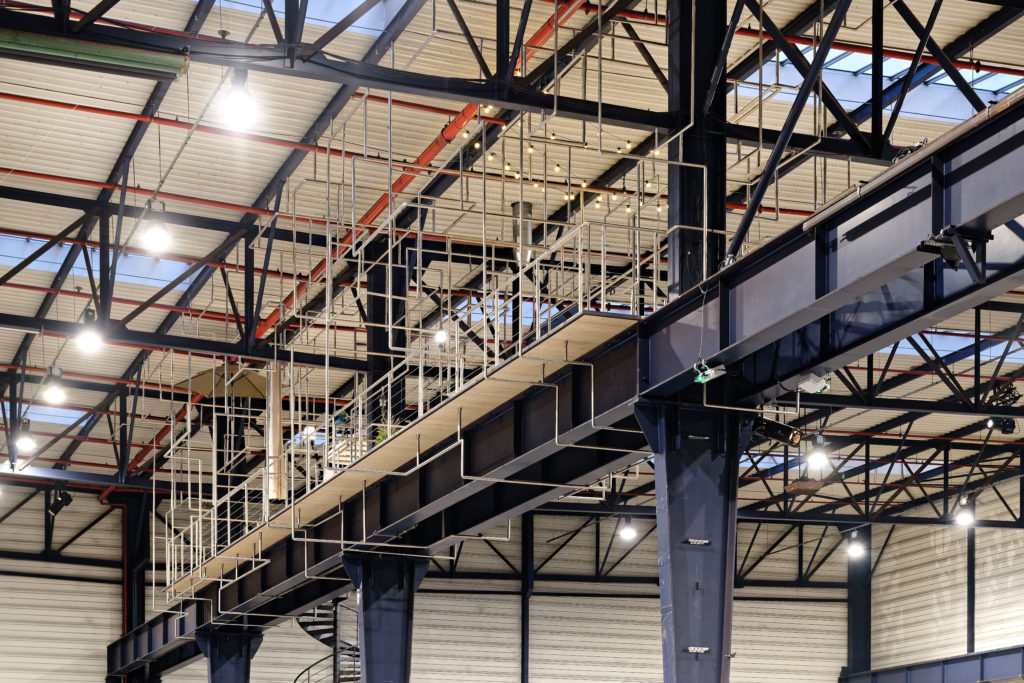Senior Curator Aaron Lister catches up with a new iteration of Yona Lee’s In Transit, showing in the Lyon Biennale.
Yona Lee has traded in her trusty City Gallery tote bag for a Palais de Tokyo one and we couldn’t be happier. Daria de Beauvais—curator at Paris’s Palais de Tokyo and one of the curators of the current Lyon Biennale—discovered Lee while she was installing her City Gallery show late last year. Lee was up a Genie hoist with her welding mask on, refiguring our gallery spaces with her maze-like networks of pipes and fittings.
After seeing the Biennale, I now understand what de Beauvais must have seen in Lee’s then-unfinished installation and how it would map onto the Biennale’s vision. Of course, she didn’t reveal too much at the time. The current Lyon Biennale seeks to unite art and industry, pairing artists with local manufacturers to make new works. Its main site is a mammoth decommissioned washing-machine factory—a perfect match with the materials, themes, and ambitions of Lee’s practice. Audaciously, Lee rose to the occasion, flipping the normal experience of her work. She lifts her structure off the factory floor to a platform suspended on a pre-existing gantry crane. Access comes via a spiral staircase. The staircase is part of the work, but, in a classic Lee feint, is presented before the experience of it. Visitors enter, become part of, and start performing the work before they realise it.
In a Biennale framed by literary tropes, Lee’s work conjures up a host of associations. First viewed, looking up from the floor, it’s a floating world. We encounter it as gesture, form, and idea, before physically entering it. Although recent iterations of
In Transit have migrated upwards, clinging to ceilings and the fittings and fixtures hidden up there, I didn’t anticipate such a dramatic upwards shift was coming or even possible. It’s a technical, engineering, and health-and-safety feat as much as a sculptural one. There is a noticeable absence—welding. The handrail manufacturer Lee worked with has developed an interlocking system that allows stainless tubes to be joined without welding. To some, this may seem a loss. The spot welds that pockmarked Lee’s smooth, industrial-metal tubes have been a key feature of her work. In removing these traces of the hand (especially within this industrial setting), the new system emphasises the structure as system and concept, rather than as made object.
Lee’s structure also serves as an elevated platform from which other works can be viewed. This is framed as a generous, non-competitive gesture on her behalf, but I’m not so sure. Lee can be seen as taking the high ground, separating herself from her peers, while encouraging us to see all the other works from her vantage point. Either way, it makes the relationships between artists that is key to any biennale another subject of the work. All biases aside, Lee’s work is a standout in the Biennale, which provides a dream theme and site for her signature investigations of materials, architecture, and visitor encounter. While other artists perhaps stretch too far to fill the factory space, or bind their work too tightly to the themes of industry and labour, Lee takes, twists, and, yes, elevates her sculptural language for the occasion. As always, her complex gesture somehow feels light and effortless.
The Biennale heaves with spatial disruptions and material transformations, pipes and metal. Yet, in seeking an ally for Lee’s project in the show, I look neither to one with a shared material language nor to one that can be seen from it. UK artist Rebecca Ackroyd’s disembodied, dismembered post-crash aircraft—with metal and human fragments forensically or archeologically reassembled on the factory floor—is a next-next-next-gen take on
The Atrocity Exhibition. Her grisly but beautiful resin forms seem to have sucked in rather than expelled the energy from the explosion they imagine (her figurative sculptures are often bathed in the same post-apocalyptic red glow). Both works make and mark out a space within the Fagor factory and the Biennale. Through setting up an embodied sculptural experience that plays on the proximity to other bodies real and imagined, present and absent, they create thresholds into physical and imaginative spaces which block out everything else, flipping and upending expectations.
—Aaron Lister
Yona Lee’s
In Transit (Highway) is on show in the Lyon Biennale,
Where Water Comes Together with Other Water, until 5 January 2020. Aaron Lister also interviews Yona Lee about the work (with an introduction by Daria de Beauvais)
here on
Contemporary Hum.







